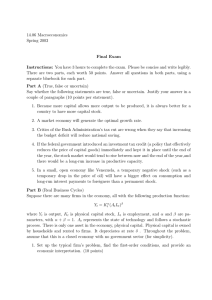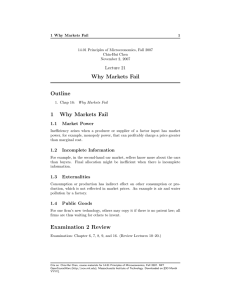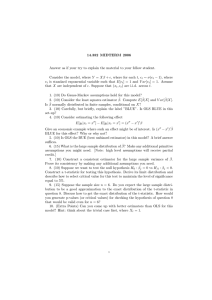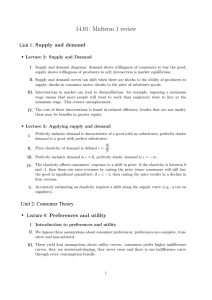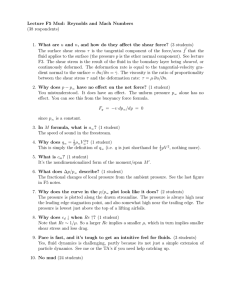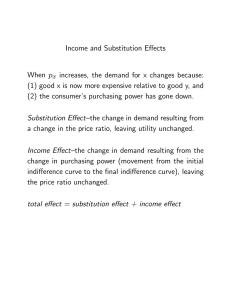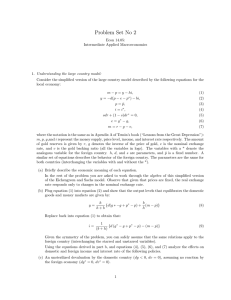14.06 Macroeconomics Spring 2003 Final Exam Solutions
advertisement
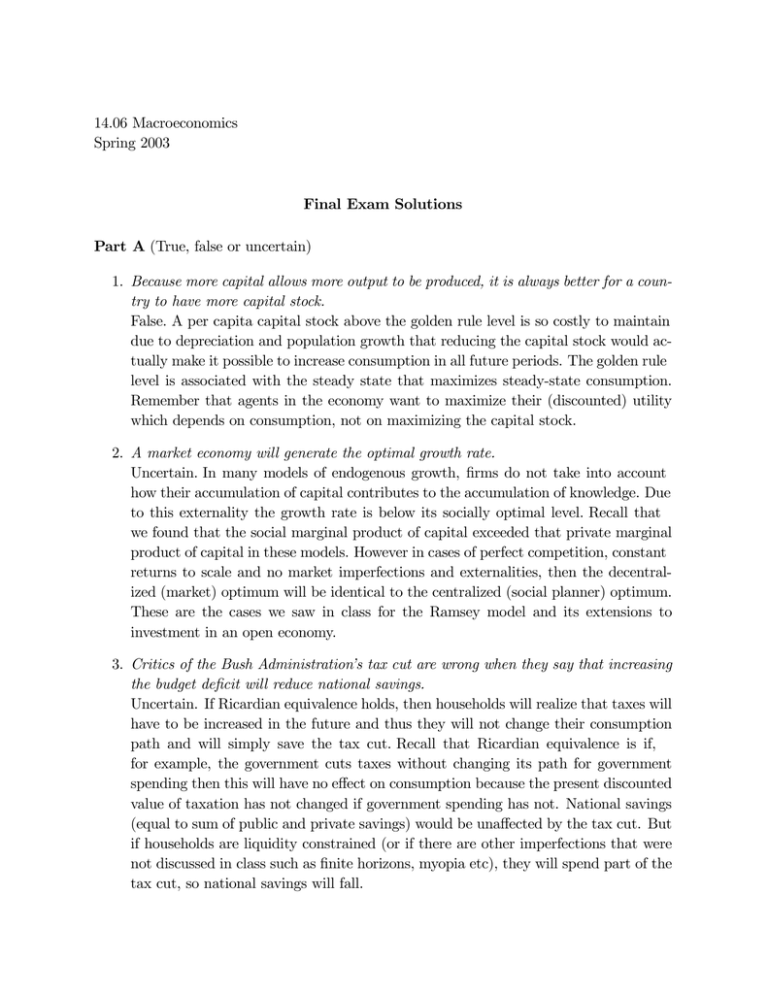
14.06 Macroeconomics Spring 2003 Final Exam Solutions Part A (True, false or uncertain) 1. Because more capital allows more output to be produced, it is always better for a country to have more capital stock. False. A per capita capital stock above the golden rule level is so costly to maintain due to depreciation and population growth that reducing the capital stock would actually make it possible to increase consumption in all future periods. The golden rule level is associated with the steady state that maximizes steady-state consumption. Remember that agents in the economy want to maximize their (discounted) utility which depends on consumption, not on maximizing the capital stock. 2. A market economy will generate the optimal growth rate. Uncertain. In many models of endogenous growth, firms do not take into account how their accumulation of capital contributes to the accumulation of knowledge. Due to this externality the growth rate is below its socially optimal level. Recall that we found that the social marginal product of capital exceeded that private marginal product of capital in these models. However in cases of perfect competition, constant returns to scale and no market imperfections and externalities, then the decentralized (market) optimum will be identical to the centralized (social planner) optimum. These are the cases we saw in class for the Ramsey model and its extensions to investment in an open economy. 3. Critics of the Bush Administration’s tax cut are wrong when they say that increasing the budget deficit will reduce national savings. Uncertain. If Ricardian equivalence holds, then households will realize that taxes will have to be increased in the future and thus they will not change their consumption path and will simply save the tax cut. Recall that Ricardian equivalence is if, for example, the government cuts taxes without changing its path for government spending then this will have no effect on consumption because the present discounted value of taxation has not changed if government spending has not. National savings (equal to sum of public and private savings) would be unaffected by the tax cut. But if households are liquidity constrained (or if there are other imperfections that were not discussed in class such as finite horizons, myopia etc), they will spend part of the tax cut, so national savings will fall. (If your answer was along the lines above, that was sufficient for full credit on this question but here are some additional implications... The above discussion abstracted from investment decisions, but now suppose that the tax cut implies an increase in after tax income for firms. In the q-theory, this implies that steady state capital increases and along the transition investment is positive. Net output, (1 − τ )f (k) − i(1 + T (i/k)), may either increase or decrease initially depending on whether the increase in output is larger or smaller than the increase in investment. In the long run, it increases. Consumption is determined by a constant share (the rate of time preference) of the PDV of net output, so it increases relative to before the tax cut (to the level at which the sum of the area between it and net output over time is equal to zero). If net output is initially below the increase in consumption, then consumers will be borrowing in anticipation of higher net output later. Private savings are equal to (1 − τ )f (k)− PDV net output, and may also fall initially, so national savings will fall initially. But in general there is no simple relation because private savings could increase initially and the effect on national savings would be ambiguous.) 4. If the federal government introduced an investment tax credit (a policy that effectively reduces the price of capital goods) immediately and kept it in place until the end of the year, the stock market would tend to rise between now and the end of the year, and there would be a long run increase in productive capacity. False. This can be analyzed in a q-theory approach, where q approximates the stock market. The effect on the stock market at impact is ambiguous, but what is unambiguous is that we are still above the steady state associated with the investment tax credit. So while the investment tax credit is in place the stock market will be falling over time as more and more capital is installed. The intuition is that because investment increases initially, the industry’s profits (aside from the tax credit) will be lower and thus the existing capital is less valuable. At the end of the year the tax credit is removed and the economy will gradually return to its old steady state, so there is no long-run increase in productive capacity. (The specifics of what is happening is discussed in the Summers paper, Figure 3. Summers considers a permanent increase in the investment tax credit but the logic extends to the case of a temporary increase. If there is an investment tax credit, then in the(q, k) space, k̇ = 0 shifts down to the new steady state value of cost of investment q∗ = 1 − φ (where φ is the tax credit per unit of investment). But if the capital stock enters the adjustment cost function, T (i/k), then the q̇ = 0 curve will shift to the right. The initial impact on q could either be an increase or a decrease depending on the saddle paths. In Summers, he draws a particular saddle path so that the initial impact is an increase but he notes that if the saddle paths were flatter, the intial effect could be a fall. In contrast, as in Romer chapter 8, if adjustment costs only depend on investment, T (i), then the q̇ = 0 curve does not shift and there is an unambiguous fall in q at time of announcement of tax credit. However, whether initial q rises or falls, it will still be above new q ∗ and will therefore fall in the transition. But then because it is temporary, will return to old equilibrium and the stock market will increase along the transition.) 5. In a small, open economy like Venezuela, a temporary negative shock (such as a temporary drop in the price of oil) will have a bigger effect on consumption and long-run interest payments to foreigners than a permanent shock. False. A temporary shock reduces wealth less than a permanent shock, so consumption will fall less (remember PDV of consumption equals PDV of wealth). However, in response to a temporary shock the economy will borrow to smooth consumption, so long run interest payments to foreigners will be higher. In response to a permanent shock there is no point in borrowing, so long-run interest payments do not change. So the statement is correct with respect to long-run interest payments but not wrt consumption. Part B 1. Because β = (1 − α), the firm exhibits constant returns to scale. The firm chooses factor inputs Kt and Lt to maximize profits at each date t Ktα (At Lt )β − wt Lt − (rt + δ)Kt where δ is the rate of depreciation. The firm increases its demand for a factor until the marginal product equals the factor price, which yields the first order conditions αKtα−1 (At Lt )β = rt + δ, βKtα Aβt Ltβ −1 = wt . 2. The household maximizes expected utility ) (∞ µ ¶t X 1 u(ct , 1 − lt ) 1 + ρ t=0 subject to its flow budget constraint. (a) The household’s flow budget constraint will be: kt+1 = kt + wt lt + rt kt − ct . b (b) If the household works one more unit today, the associated disutility is 1−l . t wt Consuming the additional labor income generates utility ct . Along an optimal path this variation cannot change utility, so we get the intratemporal optimality condition b wt = . ct 1 − lt (c) If the household reduces consumption today by one unit, the loss in utility is 1 . Investing the proceeds in capital and consumption them tomorrow gives ct expected discounted utility · ¸ 1 + rt+1 1 . Et 1 + ρ ct+1 Along an optimal path this variation cannot change utility, so we get the Euler condition · ¸ 1 1 + rt+1 1 . = Et ct 1 + ρ ct+1 3. Labor demand is given by firms’ optimization wrt labor: 1 ! 1−β Ã α β A βK t t Ldt = wt while labor supply is given by households’ optimization (from 2b): Lst = 1 − bCt . wt 4. The following discussion is valid for the baseline parameter values in section 4.7 of Romer (2001). According to these baseline parameters the shock to A will eventually die out as ρA < 1. Output will increase on impact and then gradually return to normal. The initial increase is partly due to the direct effect of higher productivity and partly due to an increase in employment (the initial capital stock is given). Over time both employment and productivity decline, which tends to reduce output. The capital stock will grow temporarily, but not enough to offset the two other forces, so over time output will fall. Labor Supply Due to the wealth effect consumption will be higher than normal during the transition but gradually return to normal. From the labor supply equation we see that the labor supply schedule will shift to the left on impact and gradually return to its initial position. (wage on y-axis and labor on x-axis) Labor Demand On impact the labor demand schedule shifts to the right due to higher productivity. The temporary increase in the capital stock will also shift the schedule outward, but eventually it will return to normal (wage on y-axis and labor on x-axis). Wage Rate As labor supply shifts to the left while labor demand shifts to the right, the wage must increase. It increases on impact, then increases for a few quarters before it gradually returns to normal. Employment The outward shift in labor demand is stronger today that it will be in the not to distant future. Thus working is more attractive today than it is tomorrow. This motive for intertemporal substitution is stronger than the wealth effect, so employment will increase on impact. But it will actually fall below normal before gradually returning to its normal level. Interest Rate On impact the interest rate increases due to higher productivity. Over time the shock to productivity will die out while temporarily the capital stock is growing. As a consequence the interest rate falls below normal before returning to its normal level. Consumption Consumption increases on impact due to the wealth effect. The high interest rate together with the Euler equation implies that for a while consumption will be growing. But eventually the interest rate falls below normal and consumption will be falling and gradually return to normal. Savings The gain from higher productivity will be smoothed over time. First savings will be higher than normal, but eventually the household will dissave. Physical Capital Physical capital is given and cannot change on impact (from 2a it depends on t-1 variables). From the discussion of savings it follows that physical capital will be increasing for a while, but eventually it will peak and then gradually return to normal. 5. (a) The capital share and labor share in income could be used to calibrate α and β. But remember we are assuming that α = 1 − β and for this to be valid, factors must be paid their marginal products. This condition can fail for various reasons such as imperfect competition, externalities, labor hoarding etc. (b) The calibration suggested in part (a) is only valid under CRS, so it fails if α + β > 1. This would imply that the Solow residuals no longer just capture technology shocks. A high Solow residual may simply be a consequence of a high level of production in combination with increasing returns to a factor.
